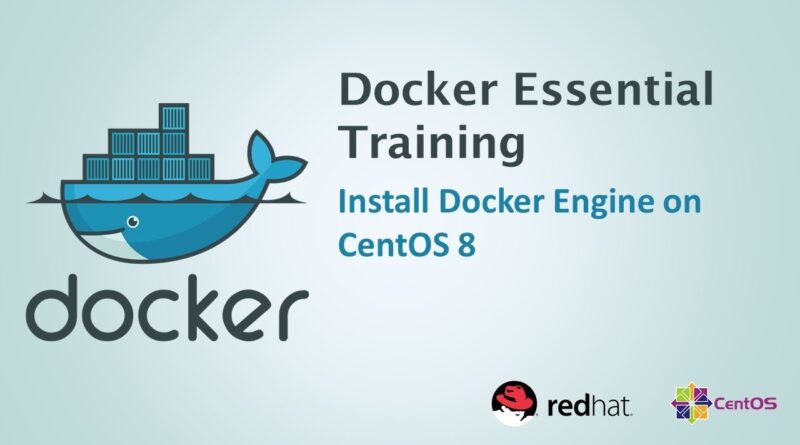Docker Essential Training, Part 01 – Install Docker Engine on CentOS 8
Docker Essential Training, Part 01 – Install Docker Engine on CentOS 8
Docker Engine is an open-source containerization technology for building and containerizing your applications. Docker Engine acts as a client-server application with:
A server with a long-running daemon process dockerd.
APIs which specify interfaces that programs can use to talk to and instruct the Docker daemon.
A command-line interface (CLI) client docker.
The CLI uses Docker APIs to control or interact with the Docker daemon through scripting or direct CLI commands. Many other Docker applications use the underlying API and CLI. The daemon creates and manages Docker objects, such as images, containers, networks, and volumes.
To get started with Docker Engine on CentOS, make sure you meet the prerequisites, then install Docker.
OS requirements
To install Docker Engine, you need a maintained version of CentOS 7 or 8.
The centos-extras repository must be enabled. The overlay2 storage driver is recommended.
Installation methods
You can install Docker Engine in different ways, depending on your needs:
Most users set up Docker’s repositories and install from them, for ease of installation and upgrade tasks. This is the recommended approach.
Some users download the RPM package and install it manually and manage upgrades completely manually. This is useful in situations such as installing Docker on air-gapped systems with no access to the internet.
In testing and development environments, some users choose to use automated convenience scripts to install Docker.
Install using the repository
Before you install Docker Engine for the first time on a new host machine, you need to set up the Docker repository. Afterward, you can install and update Docker from the repository.
SET UP THE REPOSITORY
Install the yum-utils package (which provides the yum-config-manager utility) and set up the stable repository.
$ sudo yum install -y yum-utils
$ sudo yum-config-manager
–add-repo
https://download.docker.com/linux/centos/docker-ce.repo
Optional: Enable the nightly or test repositories.
These repositories are included in the docker.repo file above but are disabled by default. You can enable them alongside the stable repository. The following command enables the nightly repository.
$ sudo yum-config-manager –enable docker-ce-nightly
To enable the test channel, run the following command:
$ sudo yum-config-manager –enable docker-ce-test
You can disable the nightly or test repository by running the yum-config-manager command with the –disable flag. To re-enable it, use the –enable flag. The following command disables the nightly repository.
$ sudo yum-config-manager –disable docker-ce-nightly
Learn about nightly and test channels.
INSTALL DOCKER ENGINE
Install the latest version of Docker Engine and containerd, or go to the next step to install a specific version:
$ sudo yum install docker-ce docker-ce-cli containerd.io
If prompted to accept the GPG key, verify that the fingerprint matches 060A 61C5 1B55 8A7F 742B 77AA C52F EB6B 621E 9F35, and if so, accept it.
Docker is installed but not started. The docker group is created, but no users are added to the group.
To install a specific version of Docker Engine, list the available versions in the repo, then select and install:
a. List and sort the versions available in your repo. This example sorts results by version number, highest to lowest, and is truncated:
$ yum list docker-ce –showduplicates | sort -r
docker-ce.x86_64 3:18.09.1-3.el7 docker-ce-stable
docker-ce.x86_64 3:18.09.0-3.el7 docker-ce-stable
The list returned depends on which repositories are enabled, and is specific to your version of CentOS (indicated by the .el7 suffix in this example).
b. Install a specific version by its fully qualified package name, which is the package name (docker-ce) plus the version string (2nd column) starting at the first colon (:), up to the first hyphen, separated by a hyphen (-). For example, docker-ce-18.09.1.
$ sudo yum install docker-ce-VERSION_STRING docker-ce-cli-VERSION_STRING containerd.io
Docker is installed but not started. The docker group is created, but no users are added to the group.
Start Docker.
$ sudo systemctl start docker
Verify that Docker Engine is installed correctly by running the hello-world image.
$ sudo docker run hello-world
This command downloads a test image and runs it in a container. When the container runs, it prints an informational message and exits.
#projectorca
#DockerEngine
#networking
#DockerCompose
#DockerSwarm
#DockerCon
#containers
#dockercontainers
#images
#dockerswarm
#dockerimages
#microservices
#docker
#container
#kubernetes
#using
#running
#devops
#image
#linux
#aws
#swarm
#dockerimage
#windows
#python
#java
#engineer
#server
#cloud
#mac
#enterprise
#app
#work
#security
#docker #devops #linux #kubernetes #stevedore #ilwu #craneoperator #longshoremen
centos 8



